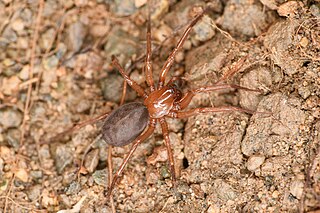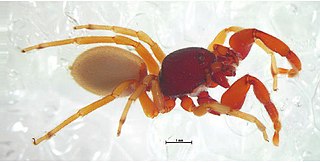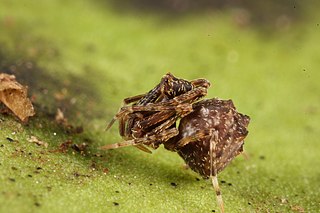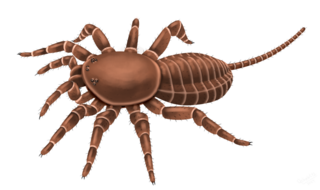
The family Dipluridae, known as curtain-web spiders are a group of spiders in the infraorder Mygalomorphae, that have two pairs of booklungs, and chelicerae (fangs) that move up and down in a stabbing motion. A number of genera, including that of the Sydney funnel-web spider (Atrax), used to be classified in this family but have now been moved to Atracidae.

Cybaeidae is a family of spiders first described by Nathan Banks in 1892. The diving bell spider or water spider Argyroneta aquatica was previously included in this family, but is now in the family Dictynidae.

Palpimanidae, also known as palp-footed spiders, is a family of araneomorph spiders first described by Tamerlan Thorell in 1890. They are widely distributed throughout the tropical and subtropical regions of the world, the Mediterranean and one in Uzbekistan, but not Australia. They are not common and there is a high degree of endemism.

Archaeidae, also known as assassin spiders and pelican spiders, is a spider family with about ninety described species in five genera. It contains small spiders, ranging from 2 to 8 millimetres long, that prey exclusively on other spiders. They are unusual in that they have "necks", ranging from long and slender to short and thick. The name "pelican spider" refers to these elongated jaws and necks used to catch their prey. Living species of Archaeidae occur in South Africa, Madagascar and Australia, with the sister family Mecysmaucheniidae occurring in southern South America and New Zealand.

Megarachne is a genus of eurypterid, an extinct group of aquatic arthropods. Fossils of Megarachne have been discovered in deposits of Late Carboniferous age, from the Gzhelian stage, in the Bajo de Véliz Formation of San Luis, Argentina. The fossils of the single and type species M. servinei have been recovered from deposits that had once been a freshwater environment. The generic name, composed of the Ancient Greek μέγας (megas) meaning "great" and Ancient Greek ἀράχνη (arachne) meaning "spider", translates to "great spider"; because the fossil was misidentified as a large, prehistoric spider.

Attercopus is an extinct genus of arachnids, containing one species Attercopus fimbriunguis, known from flattened cuticle fossils from the Panther Mountain Formation in Upstate New York. It is placed in the extinct order Uraraneida, spider-like animals able to produce silk, but which lacked true spinnerets and retained a segmented abdomen bearing a flagellum-like tail resembling that of a whip scorpion. They are thought to be close to the origins of spiders.

Lithornis is a genus of extinct paleognathous birds. Although Lithornis was able to fly well, their closest relatives are the extant tinamous and ratites.

Amyzon is an extinct genus belonging to the sucker family Catostomidae first described in 1872 by E. D. Cope. There are six valid species in the genus. Amyzon are found in North American fossil sites dated from the Early Eocene in Montana and Washington USA, as well as the British Columbian sites at McAbee Fossil Beds, Driftwood Canyon, and the "Horsefly shale", as well as Early Oligocene sites in Nevada USA. One Middle Eocene species is known from the Xiawanpu Formation of China. The Ypresian species A. brevipinne of the Allenby Formation was redescribed in 2021 and moved to a separate monotypic genus Wilsonium.
Eoplectreurys is an extinct monotypic genus of spider from the family Plectreuridae, with a sole species, Eoplectreurys gertschi. The fossils of Eoplectreurys were recovered from the ~164 Ma old Middle Jurassic Daohugou formation tuffs in Inner Mongolia, China.

Pseudosiobla campbelli is an extinct species of sawfly in the family Tenthredinidae that is known from early Eocene Ypresian stage lake deposits near the unincorporated community of Horsefly, British Columbia.
Garcorops jadis is a possibly extinct species of Wall crab spider, family Selenopidae, and at present, it is one of four known species in the genus Garcorops. The species is solely known from copal found on the beach near Sambava, on the northeast coast of Madagascar.
Palaeoperenethis is an extinct monotypic genus of nursery web spider family Pisauridae, and at present, it contains the single species Palaeoperenethis thaleri. The genus is solely known from Early Eocene, Ypresian Okanagan Highlands deposits in the Cariboo region of British Columbia, Canada.

Mongolarachne is an extinct genus of spiders placed in the monogeneric family Mongolarachnidae. The genus contains only one species, Mongolarachne jurassica, described in 2013, which is presently the largest fossilized spider on record. The type species was originally described as Nephila jurassica and placed in the living genus Nephila which contains the golden silk orb-weavers.
The Panther Mountain Formation is a geologic formation in New York. It preserves fossils dating back to the Devonian period. It is located in the counties of Albany, Madison, Oneida, Otsego, and Schoharie. It is well known for its fossil arthropods preserved as flattened cuticles, including Attercopus and Dracochela.
This list of fossil arthropods described in 2011 is a list of new taxa of trilobites, fossil insects, crustaceans, arachnids and other fossil arthropods of every kind that have been described during the year 2011. The list only includes taxa at the level of genus or species.

Seppo is an extinct genus of spiders, possibly of the superfamily Palpimanoidea, that lived about 180 million years ago, in the Early Jurassic of what is now Europe. The sole species Seppo koponeni is known from a single fossil from Grimmen, Germany. With the scorpion Liassoscorpionides, it is one of the two only known arachnids from the Lower Jurassic of Germany. Seppo is the first unequivocal Early Jurassic spider, and was recovered from the Green Series member of the Toarcian Ciechocinek Formation.
Permarachne is an extinct genus of arachnids containing the single species Permarachne novokshonovi from the Permian (Kungurian) of Russia, found in the Koshelevka Formation near the town of Suksun in Perm Krai. It is closely related to modern spiders but unlike them, it has a long thin tail, similar to its relative Attercopus, it is known from the mostly complete holotype PIN 4909/12. It is about 1 cm in size. It initially was thought to be a spider, but is now thought to form a clade with at least its close relative Attercopus, forming the grouping Uraraneida.

Lagonomegopidae is an extinct family of spiders known from the Cretaceous period. Members of the family are distinguished by a large pair of eyes, positioned on the anterolateral flanks of the carapace, with the rest of the eyes being small. They have generally been considered members of Palpimanoidea, but this has recently been questioned. Members of the family are known from the late Early Cretaceous (Albian) to near the end of the Late Cretaceous (Campanian) of Eurasia, North America and the Middle East, which was then attached to Africa as part of Gondwana. They are generally assumed to have been free living hunters as opposed to web builders.

Hiodon woodruffi is an extinct species of bony fish in the mooneye family, Hiodontidae. The species is known from fossils found in the early Eocene deposits of northern Washington state in the United States and late Eocene deposits in northwestern Montana. The species was first described as Eohiodon woodruffi. H. woodruffi is one of two Eocene Okanagan Highlands mooneye species, and one of five fish identified in the Klondike Mountain Formation.

Palaeocambarus is an extinct genus of crayfish discovered in the Yixian Formation in China, with only a single species, P. licenti. It is one of the oldest known fossil crayfish.













